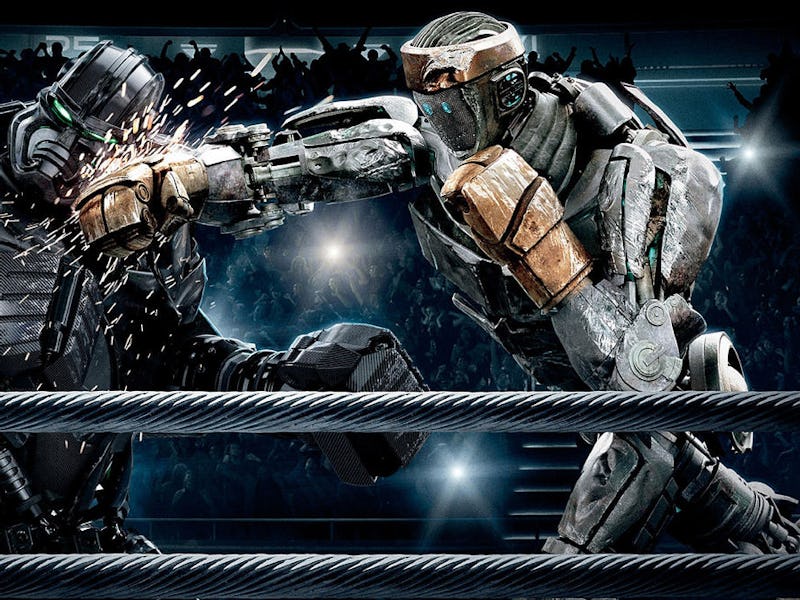Real Steel on Netflix is the uplifting sci-fi movie you need right now
In a world of gloomy superheroes and dystopian science fiction, Netflix is offering up a refreshing change of pace.

Landing on the main event card for Netflix’ October schedule is director Shawn Levy’s vastly underrated robot boxing film, Real Steel, an upper-cut of a sci-fi feature filled with old-fashioned pathos melded with knockout sequences of futuristic machine vs. machine mauling.
Before executive producing The Duffer Brothers’ Stranger Things, and after he’d delivered Night at the Museum and its sequel, Levy unleashed this near-future, family-friendly gem that seemed to come out of nowhere to ignite Hollywood’s fall fireworks.
Released on October 7, 2011 with a budget of $110 million, Real Steel easily toppled its weekend competition and eventually collected just shy of $300 million in worldwide box office receipts. Rumors of a possible sequel have circulated ever since without anything entering the development ring as key creators have moved on to other projects. But Real Steel still packs a punch to this day for one refreshing reason.
Hugh Jackman in 'Real Steel.'
Nearly a decade after its release, Real Steel remains an antidote to overburdened superhero sagas and depressing dystopian nightmares of chosen ones discovering their destinies. It’s set in a world much like our own, (the year 2020) and the production designers were smart to keep it grounded by limiting technological differences to cooler cell phones and robot gladiators.
The rousing plot is reminiscent of classic underdog sports movies and the tradition of vintage boxing classics like Body and Soul, The Champ, and Requiem for a Heavyweight. Real Steel takes this noirish subgenre and injects it with a glossy hi-tech spirit and nostalgic charm.
Hugh Jackman, muscled up in mid-season Wolverine form, plays lovable loser Charlie Kenton, an ex-prizefighter scraping together a living in the unsanctioned dungeons of underground robot boxing. When he teams up with his estranged son Max (Dakota Goyo) after hitting rock bottom, Charlie and his kid scrabble their way up the ranks with a cast-off sparring bot named Atom.
Overcoming insurmountable odds and inspired by a post-Lost Evangeline Lilly as Bailey Tallet, Charlie’s love interest, they rise all the way to the hallowed arenas of the World Robot Boxing League for a shot to win the heavyweight championship title against the mighty Zeus. And let’s not forget a pre-Marvel Studios Anthony Mackie’s energized appearance as a charismatic fight promoter.
Speaking of which, Real Steel feels like the much-needed antithesis of Marvel’s Cinematic Universe, now stuffed to the breaking point with capes and cowls. The MCU now contains nearly three dozen individual superheroes all vying for screen time, not to mention the brain space fans are expected to devote to all the narrative threads unspooling over 23 movies. It’s enough to make you wish Thanos really did wipe out half of that interconnected universe.
Real Steel’s lean script allows you to become immediately engaged, and keeps the narrative focused on the relationship between Charlie and Max while an abandoned robot with glowing aquamarine eyes acts as a focal point for their emotional and professional resurrection. It’s a modern day fable demonstrating themes of abandonment, faith, hope, and the unbridled spirit of humanity embodied by a dented, has-been android with more heart than fancy upgrades.
It's hard to raise a kid AND maintain a boxing robot at the same time.
Not based on any pre-existing mega property, comic book, graphic novel, or toy line, Real Steel’s original screenplay is instead loosely based on Steel, a cynical 1956 short story by I Am Legend’s Richard Matheson. After the legendary Rod Serling, Matheson is responsible for writing the most episodes of the original The Twilight Zone TV series than any other writer.
Steel was adapted into a Season 5 episode of The Twilight Zone which aired on October 4, 1963. Its plot unspools in the futuristic world of 1974 where human boxing is illegal and replaced by violent android matches. We follow Steel Kelly, a washed-up human boxer played by Lee Marvin, who manages an antiquated android named Battling Maxo while grappling with the fact that his sports career has been eclipsed by brawling machines. When his broken-down bot fails its physical, Kelly must disguise himself as Maxo to collect the prize money required for repairs and struggles to maintain the charade to beat the bell.
Real Steel’s biggest attraction are its jaw-dropping robot prizefighters with vivid names like Noisy Boy, Ambush, Metro, Midas, Twin Cities, and Zeus. Executive producer Steven Spielberg urged Levy to build real robots for the feature and the results are nothing less than impressive.
The imposing metal monsters earned Digital Domain visual effects supervisor Erik Nash an Academy Award nomination for his team. This combative gang was brought to life using a blend of animatronics, CGI, and talented motion-capture performers, puppeteers, and animators.
A full 48 minutes of the two-hour run time features visual effects, and Nash has admitted in a 2012 EW interview that the finest compliment he’s ever heard in describing the SFX crew’s consistent work is the seamless factor on screen, the notion that you can’t discern when you’re looking at a CGI robot or when you see an animatronic robot.
Much more than just Rocky meets Transformers, Real Steel is a satisfying tale of reconciliation that pulls no punches when it comes to pleasing its PG-13 audience. It shows us what can be accomplished when a director’s vision presents an authentic core of truth about the human condition. It’s not a perfect film by any definition, but it deserves to be elevated into the last decade’s more memorable flicks.
Real Steel is streaming now on Netflix.